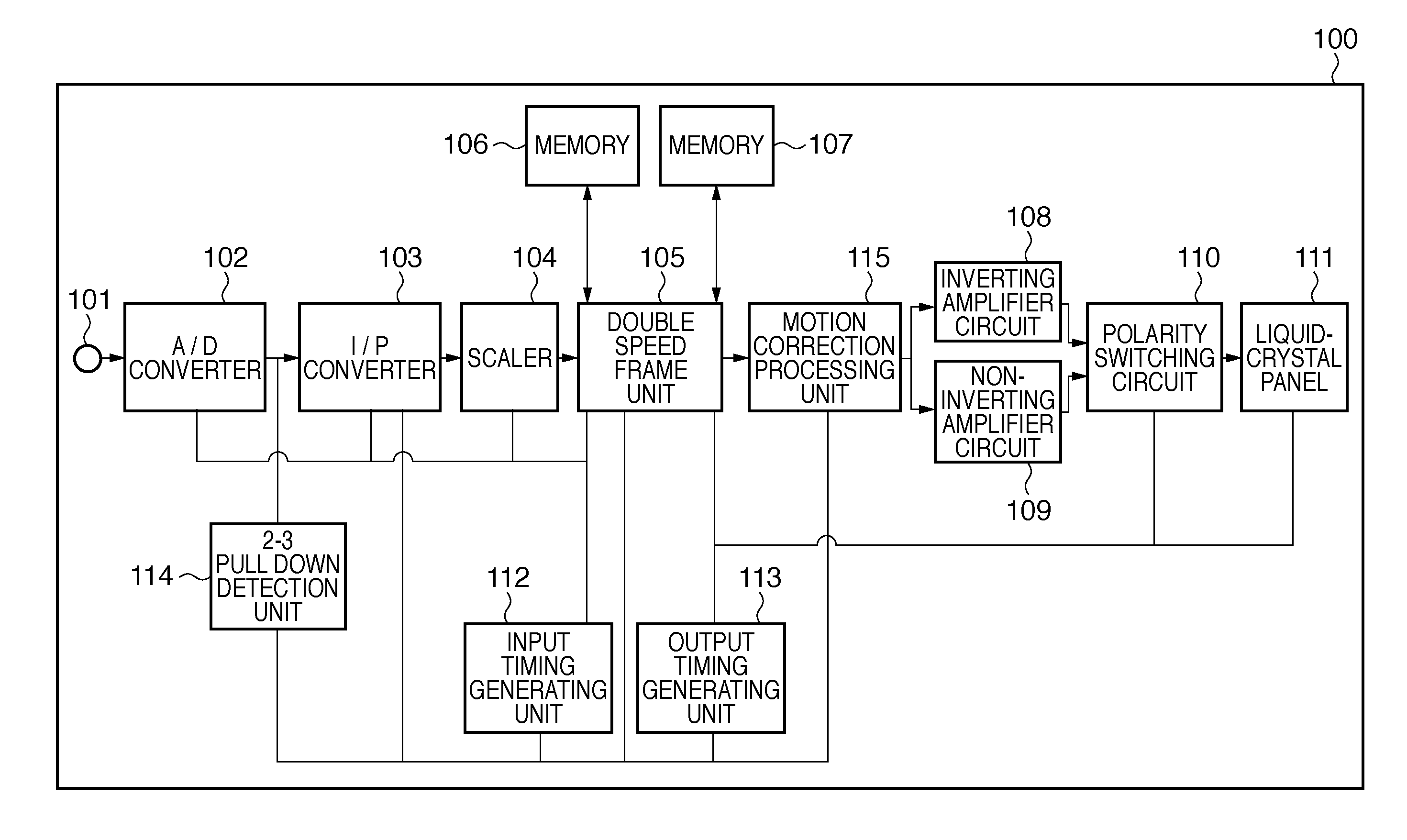Display apparatus and driving method thereof
- Summary
- Abstract
- Description
- Claims
- Application Information
AI Technical Summary
Benefits of technology
Problems solved by technology
Method used
Image
Examples
first embodiment
[0023]A first embodiment will be described below with reference to FIG. 1 to FIG. 3. FIG. 1 is a block diagram showing an exemplary configuration of a liquid-crystal display apparatus according to the first embodiment. Blocks relating to the present invention will be mainly described herein. Therefore, the configuration of a liquid-crystal display apparatus of the present invention may include other blocks. In the following description, a liquid-crystal display apparatus is used as an example of the display apparatus.
[0024]A liquid-crystal display apparatus 100 includes a video input terminal 101, an A / D converter 102, an I / P converter 103, a scaler 104, a double speed frame unit 105, memories 106 and 107, an inverting amplifier circuit 108, a non-inverting amplifier circuit 109, a polarity switching circuit 110, a liquid-crystal panel 111, an input timing generating unit 112, an output timing generating unit 113, a 2-3 pull down detection unit 114 and a motion correction processing...
second embodiment
[0046]Next, a second embodiment will be described with reference to FIG. 4. In the present embodiment, a liquid-crystal display apparatus that performs double speed frame processing, capable of improving the motion in telecine images, thereby achieving high image quality display, and improving the polarization of a DC component during AC driving will be described.
[0047]In the first embodiment, while motion blur due to the image holding properties of cinema video is improved, 2-3 patterns undergo double speed frame processing as is, and therefore discontinuous motion picture remains, which is generated by the repetition of patterns made up of different numbers of images. In other words, sets of two images or three images, the two or three images being generated from a single cinema image, undergo double speed frame processing as is. Accordingly, after the double speed frame processing, as shown with 3h in FIG. 3, sets of four images and six images are alternately repeated. For this r...
third embodiment
[0056]The third embodiment will be described next with reference to FIG. 5 and FIG. 6. In the present embodiment, a case is described in which a black inserting process is used as a motion correction process. The black inserting process refers to processing in which an image of a uniform tone (a black image, for example) is inserted into the frames whose frame rate has been doubled.
[0057]FIG. 5 illustrates a black inserting process as a comparative example. Reference numeral 5a indicates images read out from the memories 106 and 107 by the double speed frame unit 105. Reference numeral 5b indicates output from the polarity switching circuit.
[0058]As shown in FIG. 5, in a comparative example, the black image is inserted on the latter of the frames obtained by doubling the frame rate. In this case, a black image is inserted only on the negative polarity side, and therefore the DC component is polarized on the negative polarity side, thereby causing a reduction in reliability such as b...
PUM
 Login to View More
Login to View More Abstract
Description
Claims
Application Information
 Login to View More
Login to View More - R&D
- Intellectual Property
- Life Sciences
- Materials
- Tech Scout
- Unparalleled Data Quality
- Higher Quality Content
- 60% Fewer Hallucinations
Browse by: Latest US Patents, China's latest patents, Technical Efficacy Thesaurus, Application Domain, Technology Topic, Popular Technical Reports.
© 2025 PatSnap. All rights reserved.Legal|Privacy policy|Modern Slavery Act Transparency Statement|Sitemap|About US| Contact US: help@patsnap.com



